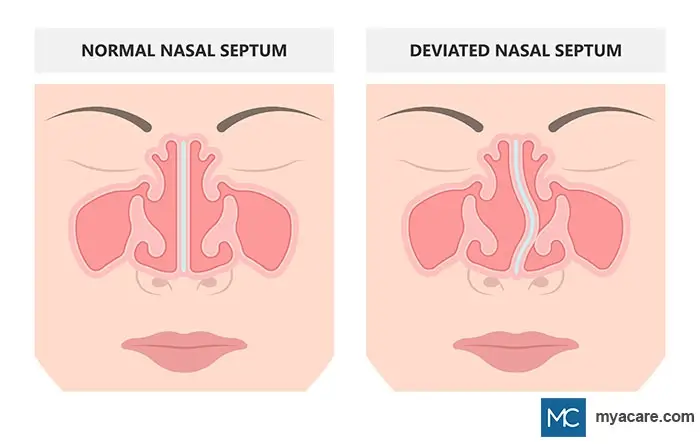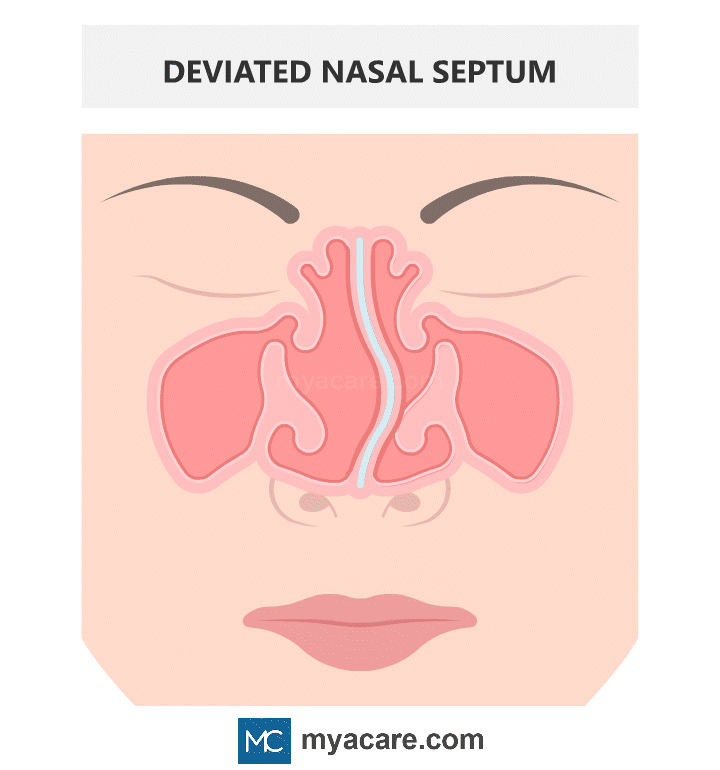Deviated Septum: Symptoms, Diagnosis, and Treatment

Septum deviation is a common condition that occurs when the septum inside the nose is uneven or off-center.
In many cases, a deviated septum does not cause any symptoms and rarely requires treatment. In other cases, it can cause congestion, nasal obstruction, chronic nasal infections, nose bleeds, and difficulty sleeping.
These symptoms are usually managed with decongestants, antihistamines, and nasal steroids. If the symptoms worsen or do not get better with medication, your doctor might recommend septoplasty surgery to correct a deviated septum.
Read on to learn more about septum deviation, its symptoms, causes, diagnosis, and treatment options.
What Is a Deviated Septum?
A deviated septum is a condition where the septum inside your nose is crooked or shifted to one side. It’s a very common condition that affects more than 80% of people to varying degrees.

The nasal septum is the thin wall of bone and cartilage that separates your right nasal cavity from your left one. Typically, the septum is centered right in the middle of the nose, separating the nostrils evenly.
When the septum is off-center or crooked, it can make one nasal cavity bigger than the other, and one nostril appears larger than the other. A severely deviated septum can block one side of the nose and cause breathing difficulties.
Symptoms Of a Deviated Septum
Many people have a deviated septum and don’t even know about it. In most cases, this condition doesn’t cause any symptoms.
However, a severely shifted septum can cause the following signs and symptoms:
- Nasal blockage: If the septum deviates too much to one side of the nose, it can cause nasal congestion or obstruction and make it harder to breathe through the nose.
- Recurring sinus infections: A deviated septum can cause swelling inside the nose and worsen the congestion. Hence, people with septal deviation are more likely to get sinusitis.
- Nose bleeds: The drying effects of the airflow in the nose can cause occasional nosebleeds in some people with a crooked septum.
- Dry mouth: Nasal blockage from a deviated septum can lead to chronic mouth breathing resulting in a dry mouth.
- Loud breathing during sleep: Snoring is often the result of a deviated septum blocking the nose’s airway during sleep.
- Sleeping troubles: Septum deviation can cause or worsen sleep disturbances, such as sleep apnea (when your breathing stops and starts while you sleep).
- A crooked nose: When the septum is uneven, the entire nose can look asymmetrical and crooked, tilted more towards either the right or the left side.
- Facial pain: Doctors suggest that a severe septum deviation may cause one-sided facial pain because of the increased pressure inside the constricted side of the nose..
- Headaches: Nasal congestion can cause pressure inside the nose leading to headaches.
You should see an ENT (Ear, Nose, Throat) doctor if you’re experiencing frequent sinus infections, nose bleeds, or difficulty breathing.
What Causes a Deviated Septum?
A deviated nasal septum may be congenital (present since birth), or the condition may occur as a result of a nose injury.
The most common causes of nasal injuries that lead to a deviated septum include the following:
- Contact sports, such as boxing, football, ice hockey, and lacrosse
- Motor vehicle accidents
- Fights
- Falls
The symptoms of a nasal septum deviation could worsen with age or an infection that causes swelling and further blocks the nasal passages.
How To Diagnose A Deviated Septum?
In many cases, a deviated septum causes no symptoms and goes unnoticed. If you’re having trouble breathing or other nasal symptoms, book an appointment with your doctor.
To confirm a deviated septum diagnosis, your doctor will do the following:
- They will ask you questions about your symptoms (trouble breathing, snoring, sinus infections), their severity, how long they last, and how often they occur
- If your nose is very congested, your doctor will apply a decongestant to reduce swelling before examining your nose
- Then, your doctor will use a bright light and a nasal speculum (an instrument that spreads open your nostrils) to view the inside of your nose
- In some cases, a nasoscope ( a long, thin, tube-like scope with a bright light at the tip) may be used to see farther back into your nose
Based on this examination, your doctor can determine whether you have a deviated septum and how severe your condition is.
You can also check yourself for a deviated septum at home.
Deviated septum self-check
The steps of the DIY self-test for a deviated septum include the following:
- Clear your nose of mucus
- Face a mirror and tilt your head back until you can see the thin wall separating your two nostrils (columella)
- If the columella is tilted towards one nostril more than the other, you might have a deviated septum.
You can also do the following breathing test to tell whether you might have a deviated septum:
- Clear your nose of mucus
- Keep your mouth closed, block one nostril with your finger, and breathe through the other for 2 minutes.
- Repeat with the other nostril blocked instead.
- If you experience difficulty breathing through one of your nostrils while the other is closed, you might have septum deviation.
Breathing difficulties and nasal obstruction may have other causes beside a deviated septum. The best way to confirm septum deviation is by consulting an ENT (Ear, Nose, Throat) doctor.
How Is a Deviated Septum Treated?
Managing the symptoms of a deviated septum
In most cases, treatment for septumdeviation is not necessary. Instead, your doctor will help you manage your symptoms by prescribing the following:
- Decongestants: These are medications that come in spray or pill form. They help reduce swelling in the nose, open up the nasal airway, and improve breathing. However, doctors usually recommend using decongestants for only a short period because they can cause dependency.
- Antihistamines: These medications help relieve the symptoms of allergies, including congestion. Antihistamines can relieve the symptoms of nasal obstruction by reducing swelling in the nose.
- Nasal steroid sprays: Although steroids do not cure septum deviation, they can provide temporary relief by reducing the swelling of nasal mucous membranes.
- Nasal strips: These are flexible, adhesive, spring-like bands applied over the bridge of the nose. Once the nasal strip adheres to the skin, it starts straightening back into its original shape. In the process, it spreads open the nostrils and improves breathing.
- Nasal dilator: This device fits inside the nostrils, expands the nasal passages, and allows more air to flow into the nose.
In case your symptoms don’t improve with medication or nasal devices, or if your crooked septum is causing you cosmetic concerns, your doctor may recommend a surgery called septoplasty.
Surgical repair of a deviated septum
Surgery is the only way to permanently fix a deviated septum and correct the appearance of a crooked nose.
Septoplasty or septum deviation surgery is a nose surgery done to straighten a deviated septum and relieve the symptoms associated with this condition.
It’s a relatively minor procedure that lasts around an hour and a half, and patients can usually return home to recover the same day. During your septoplasty, your surgeon repositions the bone and cartilage of your septum to realign it.

Septal deviation surgery can:
- Relieve nasal obstruction, stuffiness, and congestion
- Prevent recurring sinusitis
- Straighten an uneven nose
- Fix asymmetrical nostrils
- Fix breathing troubles, reduce snoring, and improve sleep
A septoplasty is often performed as part of a rhinoplasty (regular nose reshaping surgery) to relieve symptoms of a deviated septum and fix the nose’s overall appearance.
In some cases, nasal surgery can completely relieve nasal obstruction and other symptoms of septum deviation. In other cases, surgery on its own is not enough, and additional treatment is required to treat nasal conditions, such as sinus infections.
You can discuss treatment options with your doctor if you have a deviated septum causing you breathing problems, sleep troubles, chronic sinus infections, or even cosmetic concerns.
To search for the best Ear Nose And Throat (ENT) healthcare providers in Germany, India, Malaysia, Spain, Thailand, Turkey, the UAE, the UK and the USA, please use the Mya Care search engine.
Dr. Mersad is a medical doctor, author, and editor based in Germany. He has managed to publish several research papers early in his career. He is passionate about spreading medical knowledge. Thus, he spends a big portion of his time writing educational articles for everyone to learn.
Sources:
Featured Blogs



